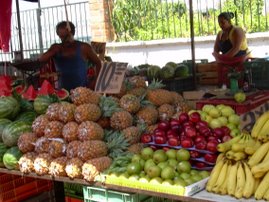 We returned last night from our expedition to Michoacan to visit the Monarch butterfly sanctuary. The weather was splendid, and the warm sun warmed the hundreds of thousands of butterflies to leave their tree branches where they spend the night and colder days. As we approached the 9000 foot sanctuary on horseback, the Monarchs became thicker and thicker in the air, filling the sky and alighting on branches, even sometimes on us. It was a spectacle like no other. Here are photos which show the monarchs clinging to the trees and filling the sky:
We returned last night from our expedition to Michoacan to visit the Monarch butterfly sanctuary. The weather was splendid, and the warm sun warmed the hundreds of thousands of butterflies to leave their tree branches where they spend the night and colder days. As we approached the 9000 foot sanctuary on horseback, the Monarchs became thicker and thicker in the air, filling the sky and alighting on branches, even sometimes on us. It was a spectacle like no other. Here are photos which show the monarchs clinging to the trees and filling the sky:

The story of the monarch migration is an astounding story, and one of nature's unexplained miracles. It had been known for years that Monarch butterflies from the Northeastern US and Canada migrated south for the winter. They had been tagged and traced as far as Texas, but their final destination had never been discovered. Finally in 1975, with help from Mexican loggers who had witnessed the migration, scientists found the unique 60 square mile area in the mountains of the State of Michoacan, Mexico, where the Monarchs make their winter home. Since that time, people from all over the world have been making pilgrimages to Mexico to see the Monarchs in Michoacan. Today, there are six separate sanctuaries where the butterflies are protected. Some of these sanctuaries are at risk because of illegal logging in the area, which is causing erosion and damaging the natural habitat.
 The story of how the Monarchs get to Mexico is even more remarkable. The generation of Monarchs which makes the journey south are born in September throughout the Northeastern US and Canada. They begin their journey south in September and arrive in Central Mexico by late October or early November. These fragile insects, weighing about a half a gram, fly alone or with just a few others, sometimes crossing the Great Lakes, and braving wind and rain, flying between 50 and 150 kilometers a day, apparently. No one can explain how they all know where to go, high in the mountains of a small area in Mexico, where the temperature and humidity are perfect for their winter survival. They go into a form of hibernation, clinging to the trees, as their body temperature drops and they conserve fat for the spring. Beginning in February and March, the sun warms and they become more active, gathering nectar and moisture during the day, returning to their tree protection at night. In mid March, they mate, and begin their long flight north. This generation, which has survived the trip down to Mexico and has wintered over, lay their eggs in Texas or Arkansa, and die around May 15. Subsequent generations only live for four or five weeks, so it takes as many as four generations to make it back to the Northeast and Canada by August. Then, in September, the generation which will live for eight months and migrate south, is born again.
The story of how the Monarchs get to Mexico is even more remarkable. The generation of Monarchs which makes the journey south are born in September throughout the Northeastern US and Canada. They begin their journey south in September and arrive in Central Mexico by late October or early November. These fragile insects, weighing about a half a gram, fly alone or with just a few others, sometimes crossing the Great Lakes, and braving wind and rain, flying between 50 and 150 kilometers a day, apparently. No one can explain how they all know where to go, high in the mountains of a small area in Mexico, where the temperature and humidity are perfect for their winter survival. They go into a form of hibernation, clinging to the trees, as their body temperature drops and they conserve fat for the spring. Beginning in February and March, the sun warms and they become more active, gathering nectar and moisture during the day, returning to their tree protection at night. In mid March, they mate, and begin their long flight north. This generation, which has survived the trip down to Mexico and has wintered over, lay their eggs in Texas or Arkansa, and die around May 15. Subsequent generations only live for four or five weeks, so it takes as many as four generations to make it back to the Northeast and Canada by August. Then, in September, the generation which will live for eight months and migrate south, is born again.No one can explain how the Monarchs know where to go. After all, they were born in Canada, Maine, Pennsylvania or some other northeast area, and have never been to Mexico. But they know how to get there, and do every year, despite incredible odds. This map reproduced from Google Images shows the Monarch migration pattern. Notice that most of the western Monarchs winter over in California.

As far as our trip went, we stayed at a beautiful lodge in Zitacauaro, Michoacan, which does a lot of business this time of year when the Monarch sanctuaries are active. We met interesting people from Switzerland, Australia, Montana, and Wisconsin who had traveled to Mexico to see this phenomenon. The owners of the lodge, a couple from Yugoslavia and France, hired a guide to take us to an unspoiled, non-touristed sanctuary by horseback. Since I had not ridden a horse for 45 years, I was a bit leery of this, as was Pixie. But these horses were experienced with walking up mountain trails. We were able to stop for a picnic lunch in a sunny clearing, as hundreds of monarchs flitted around us. Once we got to the heart of the sanctuary, we could see literally hundreds of thousands of the butterflies clinging to trees and flying. The sound of thousands of butterfly wings flapping is similar to that of a light steady rain. We had to be silent and stay behind the roped off area. We stayed there for over an hour, just marveling at the spectacle. Here are more photos:




Here are some photos of the lodge where we stayed, and Pixie and I with Jeanne and Paul at breakfast.


And so,we have returned from our little adventure, perhaps a bit sore from riding horseback but happy to have seen this miracle of nature. As Unitarian Universalists, we believe we are all on our own spiritual journey, and we often take our spiritual meaning from nature itself, as did the Transcendentalists like Emerson and Thoreau. This was a spiritual experience, unexplainable by our science. How these creatures manage manage so predictably to winter in this small area of central Mexico is a mystery, but one which we have been fortunate enough to share with them for a brief moment.


















































































